This simple and fool-proof oven roasted whole chicken recipe is perfect for weeknight dinners!
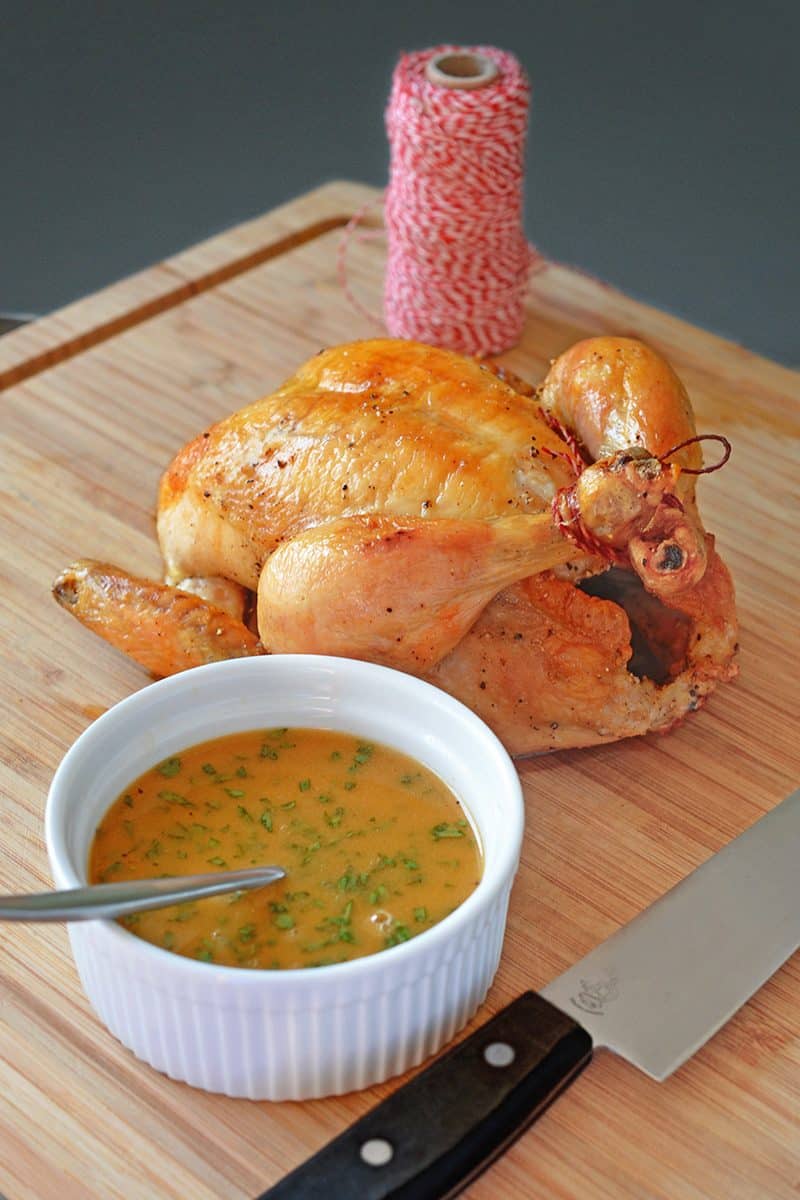
Table of Contents
A simple oven roasted whole chicken recipe!
Who says chicken-roasting is strictly a weekend affair? Survey says…NOBODY—especially with this simple and satisfying Weeknight Roast Chicken recipe. It comes straight out of the newest cookbook from the food nerds at America’s Test Kitchen, The Cook’s Illustrated Meat Book: The Game-Changing Guide that Teaches You How to Cook Meat and Poultry with 425 Bulletproof Recipes.
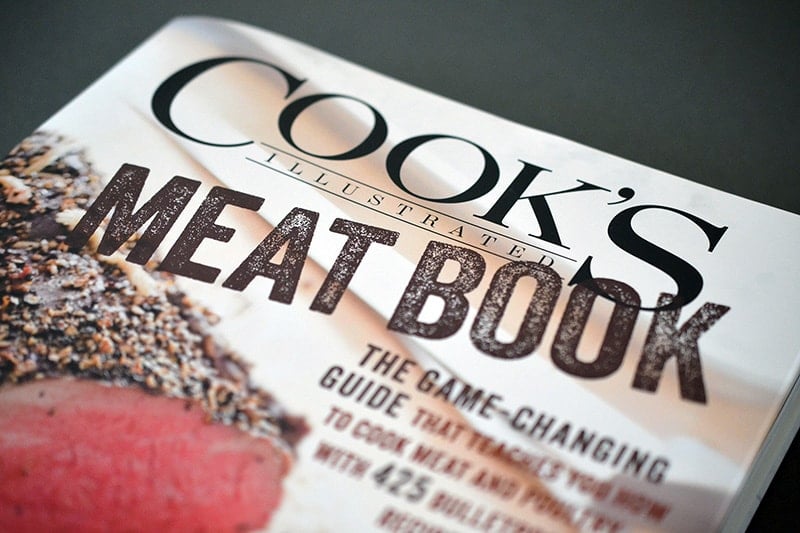
This carnivore-pleasing tome isn’t the first ATK book in my collection. Over the years, I’ve amassed over 30 of their books. (I’ve lost count, actually.) I don’t like to think of myself as a hoarder; I just can’t resist the lure of guaranteed-awesome recipes that have been tested dozens of times. The crew at ATK’s done all the tweaking and testing so that you and I can follow their recipes knowing that even dummies like us can’t screw things up too badly.
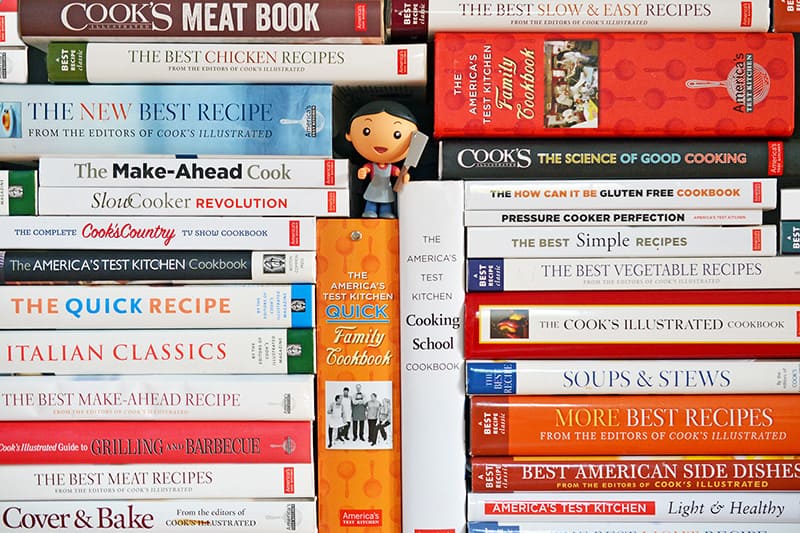
Another winner, winner chicken dinner from ATK!
ATK’s dishes are always solid, but its recipe for Weeknight Roast Chicken is a real game-changer. No fancy ingredients or techniques are needed; just grab a whole chicken, salt, pepper, some fat, a piece of string, and a meat thermometer, and PRESTO-CHANGE-O!—in less than 5 minutes, the chicken’ll be ready for the oven.
Best of all, The Meat Book reveals the secret to moist chicken: Turn off the oven midway through the cooking time.
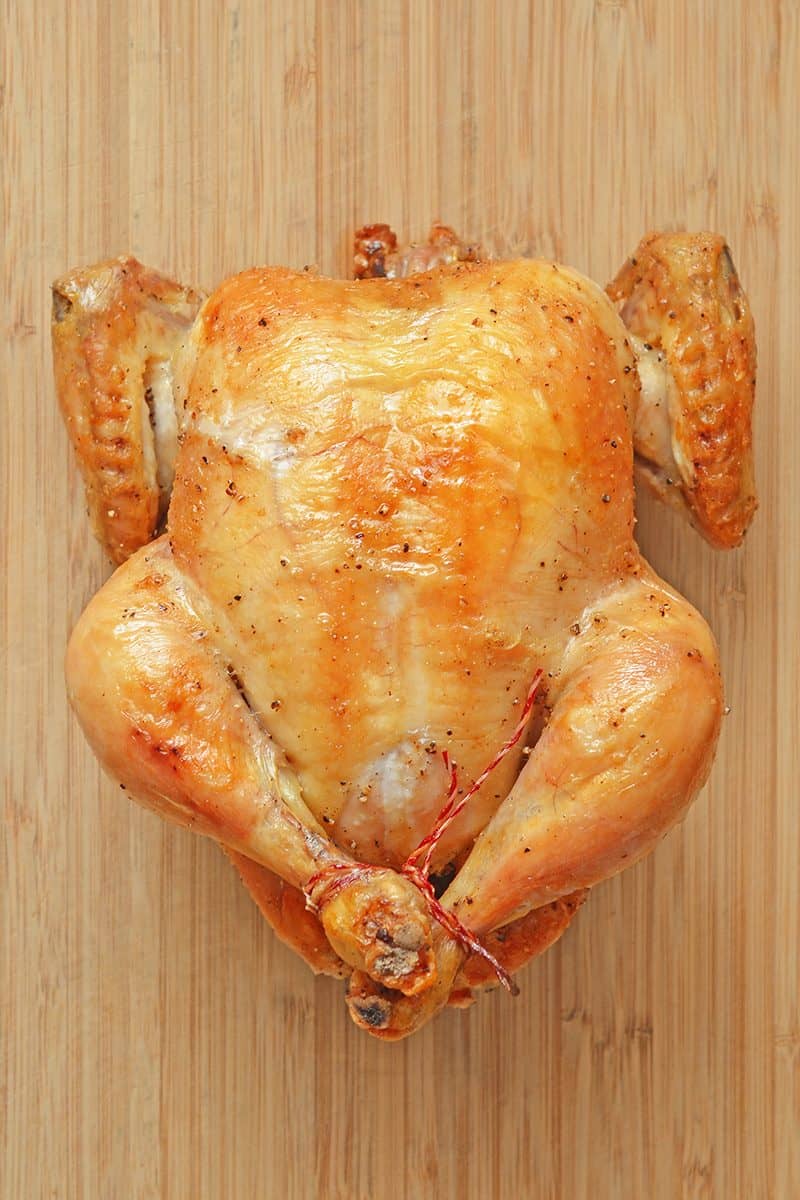
I’ve tried it. It works. It’s genius.
Ingredients
For the chicken
- 1 (3½- to 4-pound) whole chicken, giblets discarded
- Diamond Crystal brand kosher salt
- Freshly ground black pepper
- Melted ghee (or fat of choice, like olive oil or avocado oil)
For the optional Tarragon-Lemon Pan Sauce
- Shallot: Feel free to substitute an onion or leek in place of the shallot!
- Chicken broth or bone broth
- Dijon mustard
- Unsalted butter (or cold ghee for folks doing a Whole30)
- Minced fresh tarragon: Feel free to substitute other herbs, like thyme or rosemary!
- Freshly lemon juice
- Freshly ground black pepper
How to make an oven roasted whole chicken
Position your oven rack in the middle position, place a 12-inch oven-safe skillet on it, shut the oven door, and crank the heat up to 450°F.
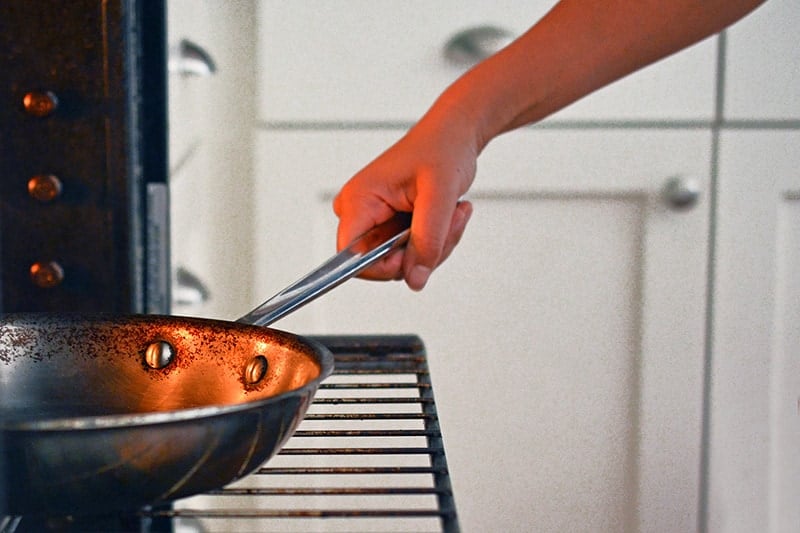
Mix together the salt and pepper in a small bowl, and grab the melted ghee.
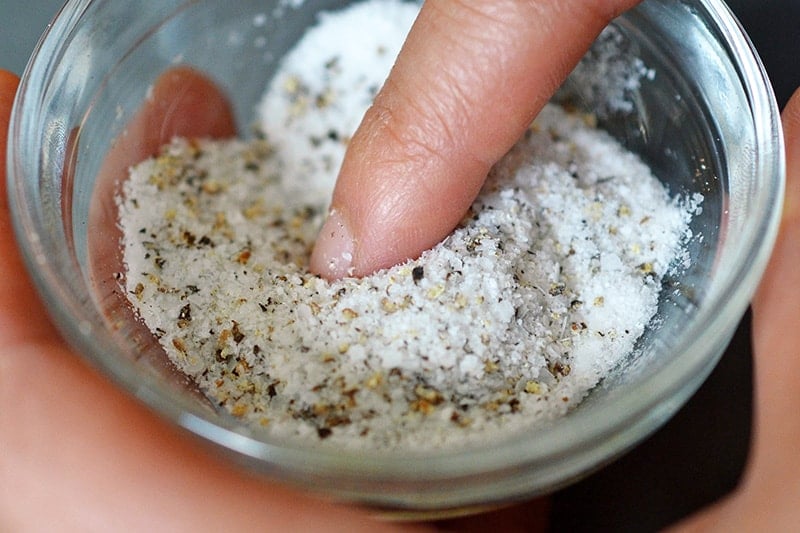
Pat the chicken dry with paper towels.
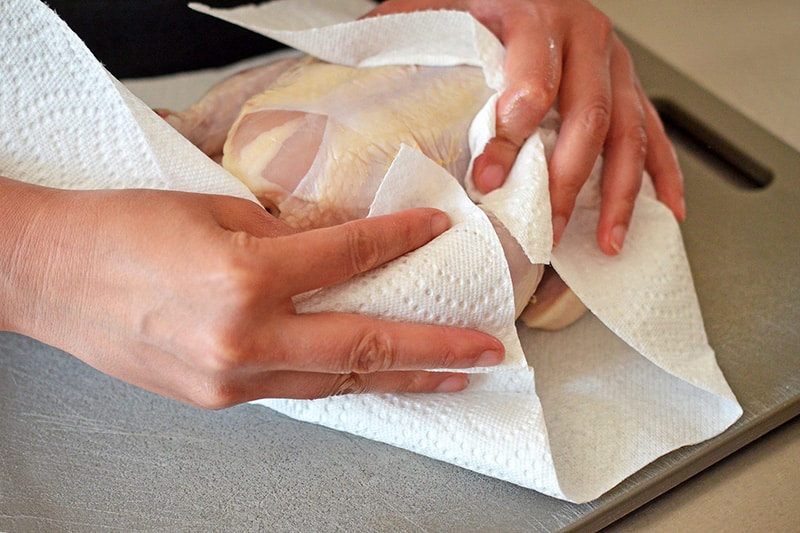
Really. Don’t skip this part. No one likes handling a slick chicken.
Pull off any extra fat around the open cavity, and trim away any extraneous skin.
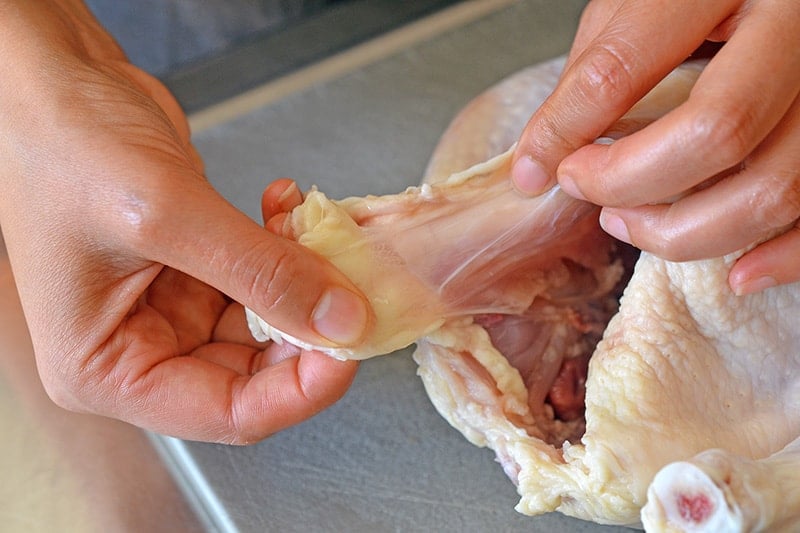
(If you happen to spot any remaining feathers, just pluck ’em out. Don’t get squeamish on me.)
Brush the entire surface of the bird with melted ghee. If your chicken is still cold from sitting in the refrigerator, the ghee may clump up a bit upon contact with the bird, but that’s no biggie.
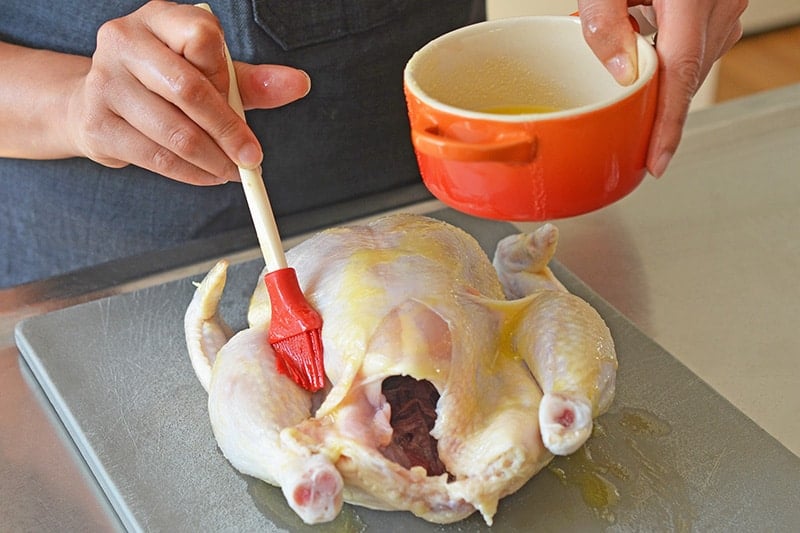
See my face? That’s not a worried expression.
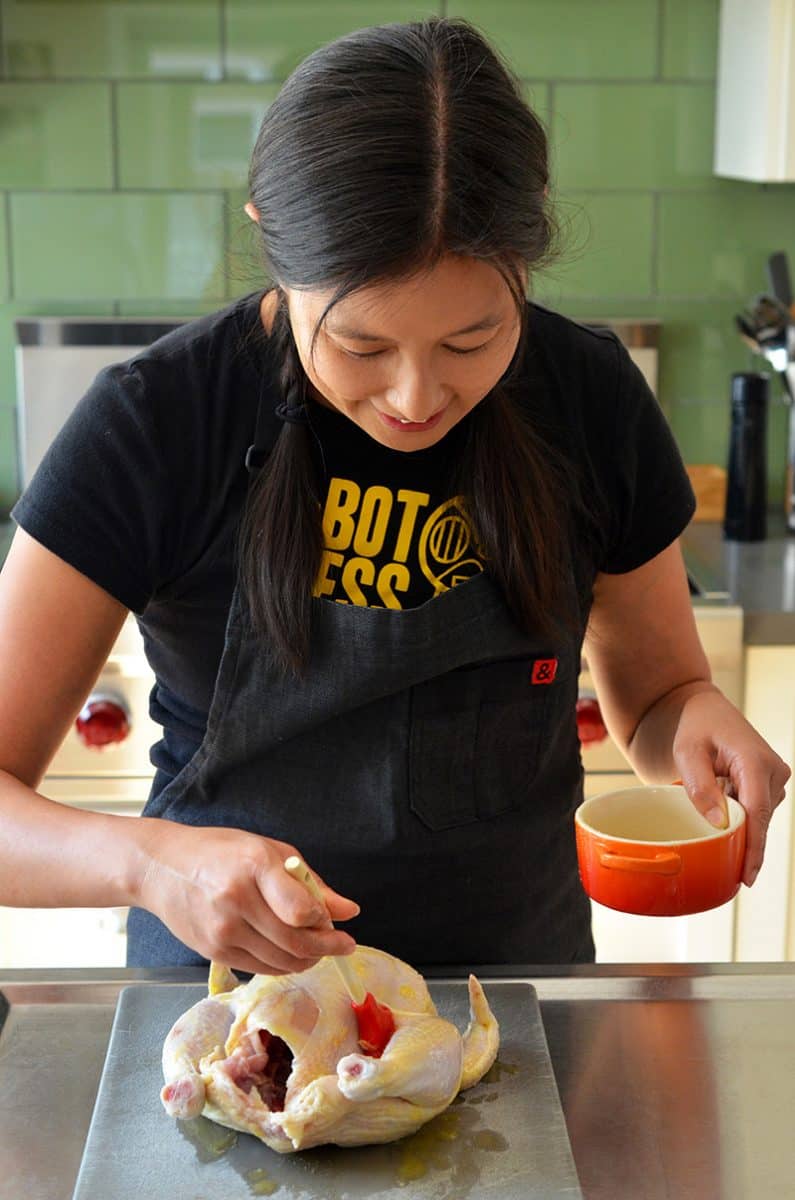
Sprinkle the salt and pepper mixture all over the surface and interior of the bird. Then, massage in the seasoning with your hands.
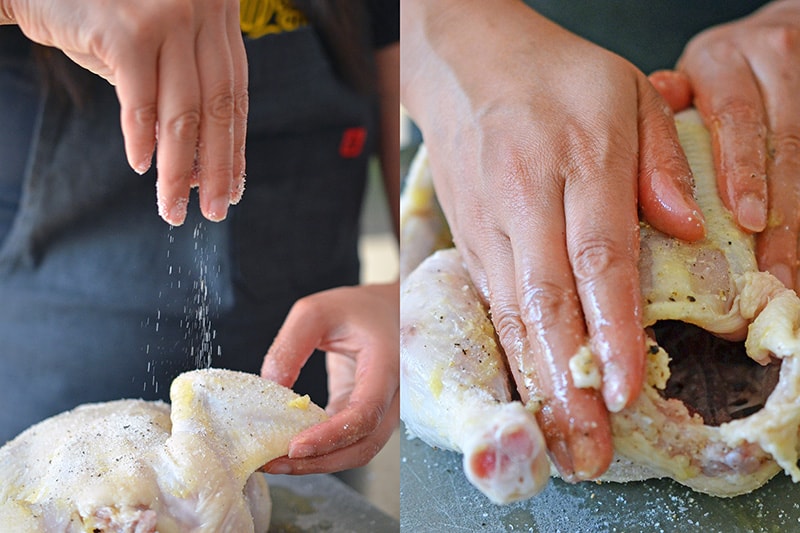
Tuck the chicken wings behind the back to keep ’em from burning in the oven…
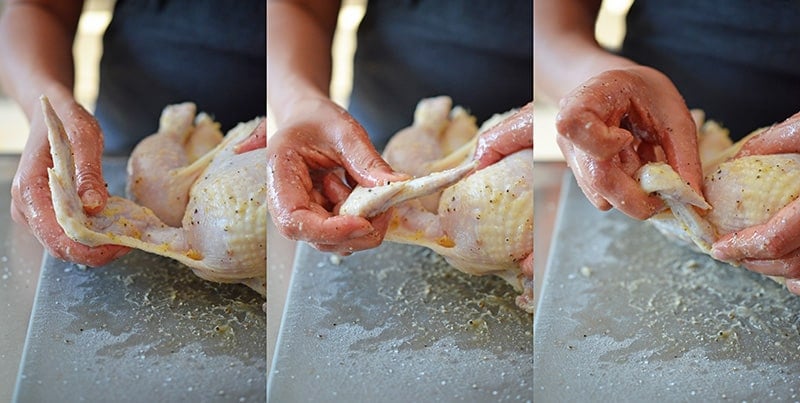
…and tie the legs together with a piece of kitchen twine.
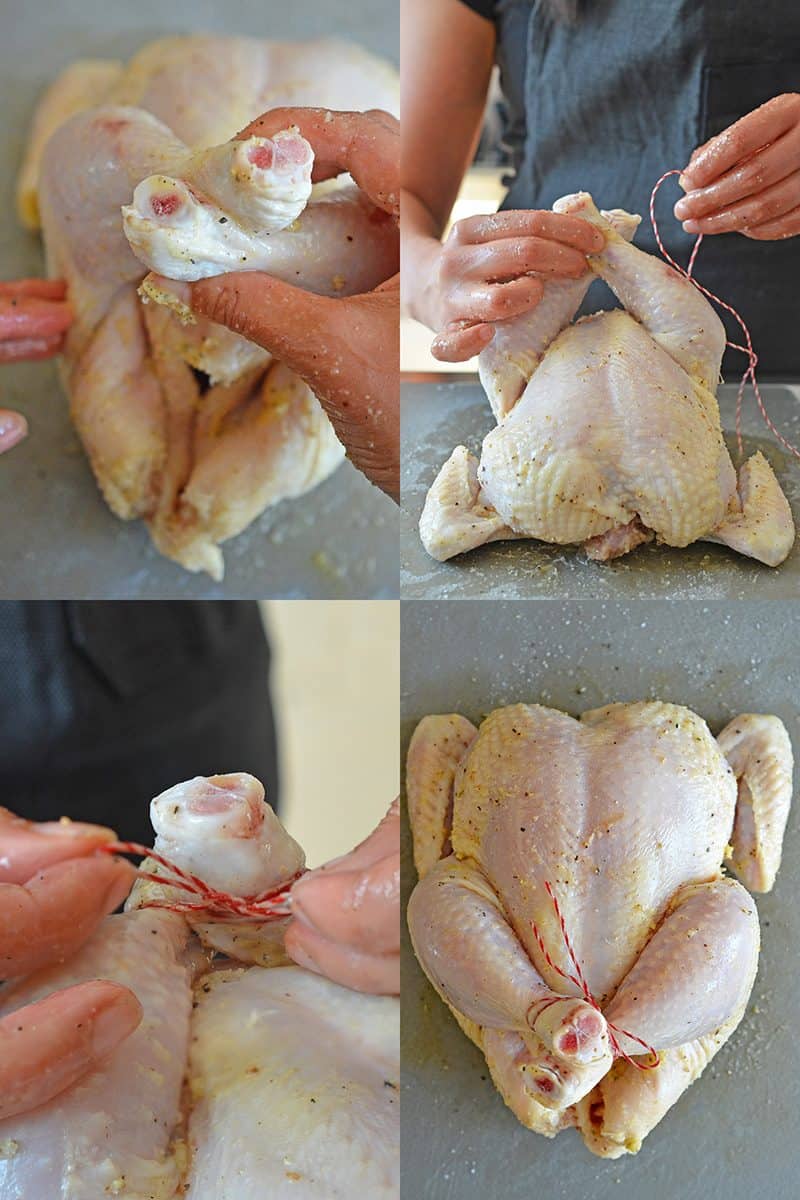
Dainty, right?
Now the bird’s ready for the oven. Place your bird breast-side up in the hot skillet in the oven. Remember that your skillet’s hot—don’t burn your hand.
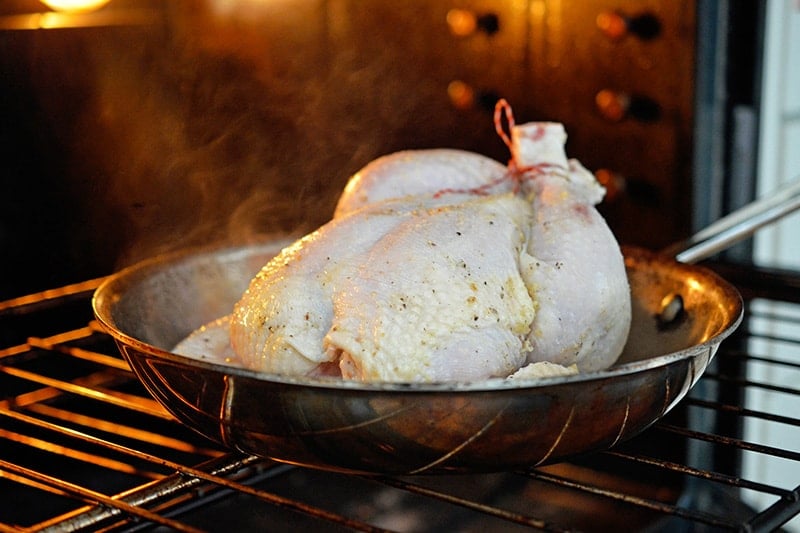
Roast the chicken until the chicken breasts register 120°F and thighs are 135°F, about 25 to 35 minutes. (If you haven’t already invested in an instant-read thermometer, I recommend that you do it. It’s a great insurance policy against ruined dinners.)
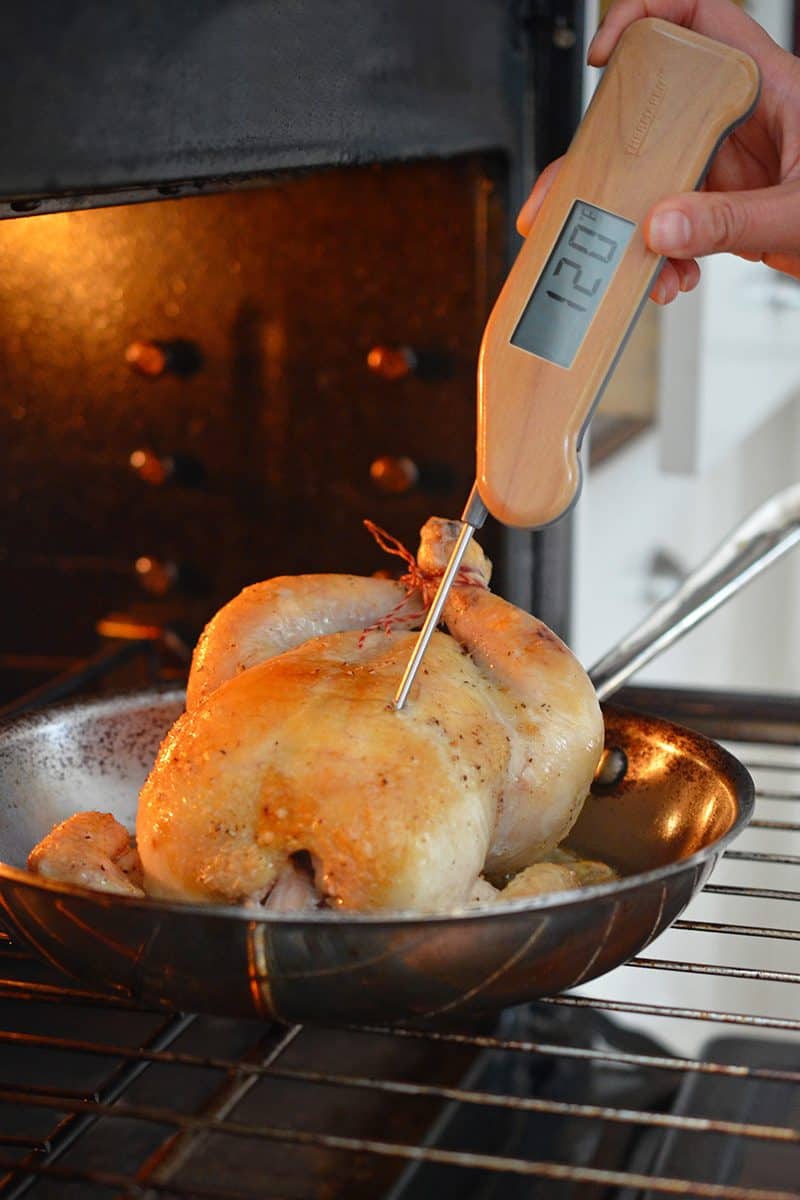
Immediately turn off the oven, leaving the chicken inside until the breast reaches 160°F and thighs are 175°F, about 25 to 35 more minutes. Again, use your meat thermometer to check your bird for readiness.
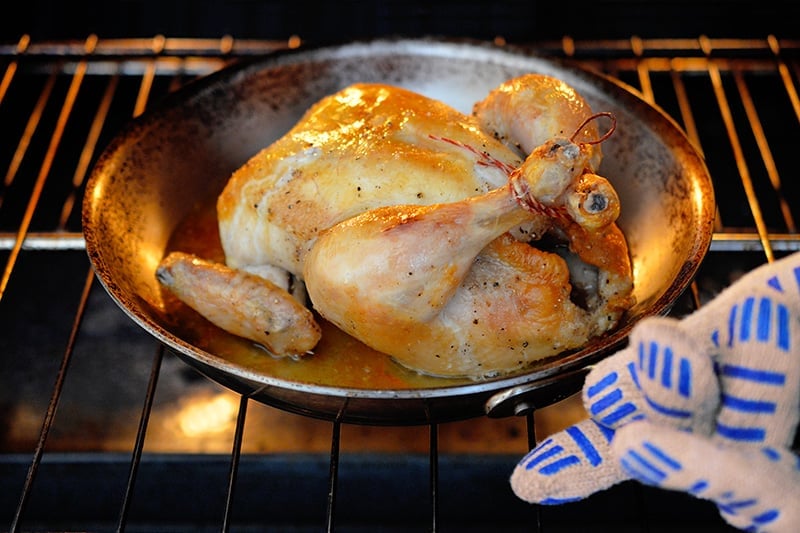
Remove the chicken from the pan and rest it for 20 minutes.
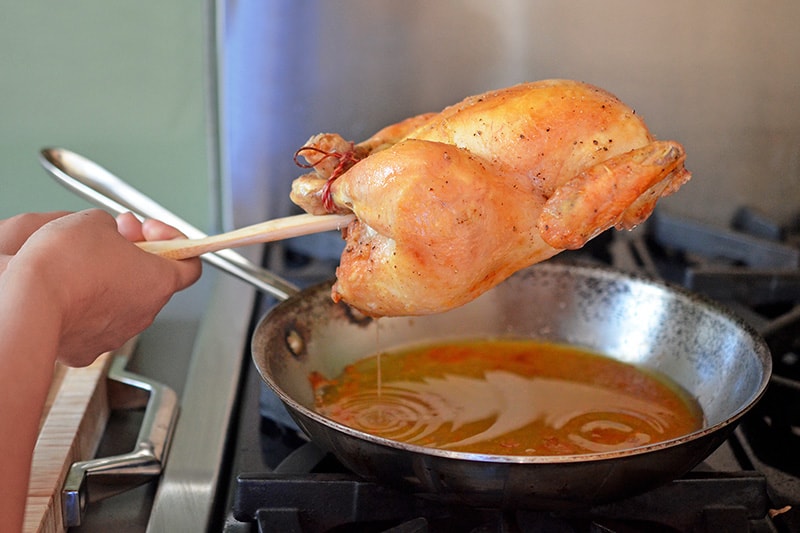
I used to use a pair of tongs to transfer roast chicken from pan to plate, but found that the teeth of my tongs would tear the beautifully crisp, golden skin. The solution? I now insert the handle-end of a sturdy wooden spoon or spatula into the bird’s cavity to lift it up and out—and to drain out any excess juices from the inside of the chicken.
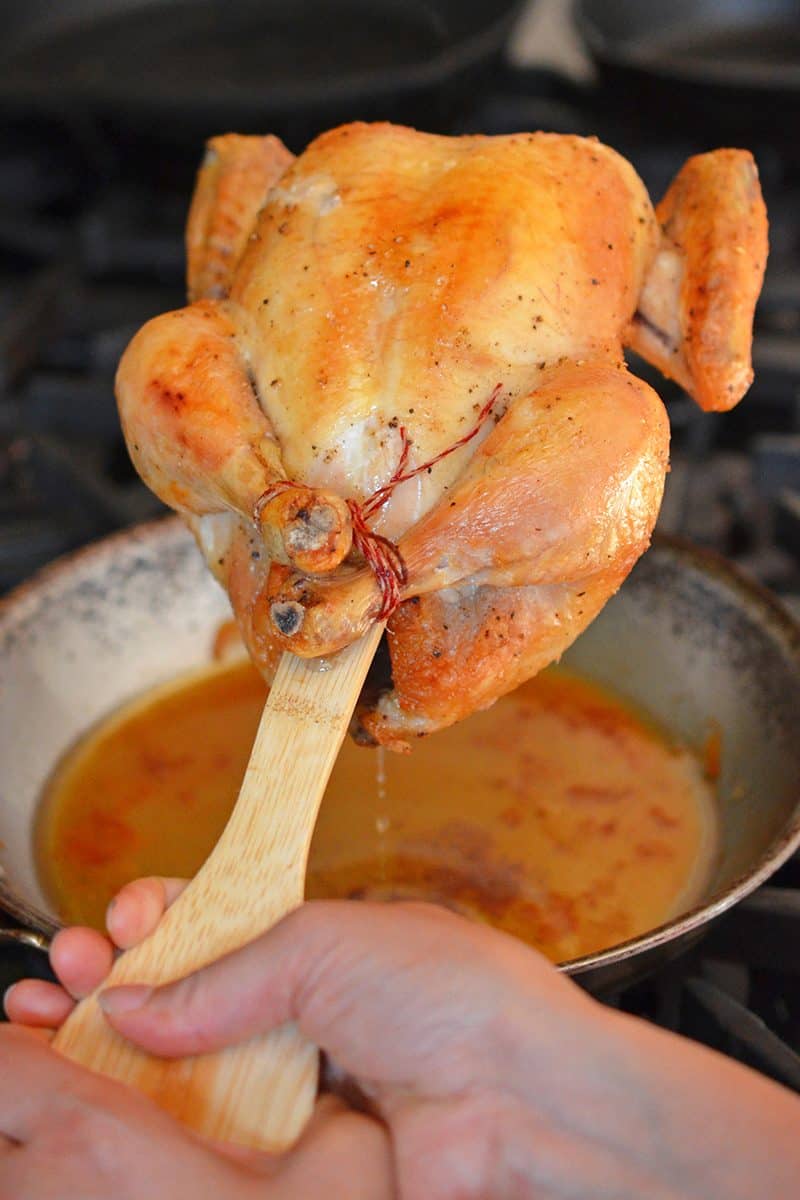
While the chicken’s resting…
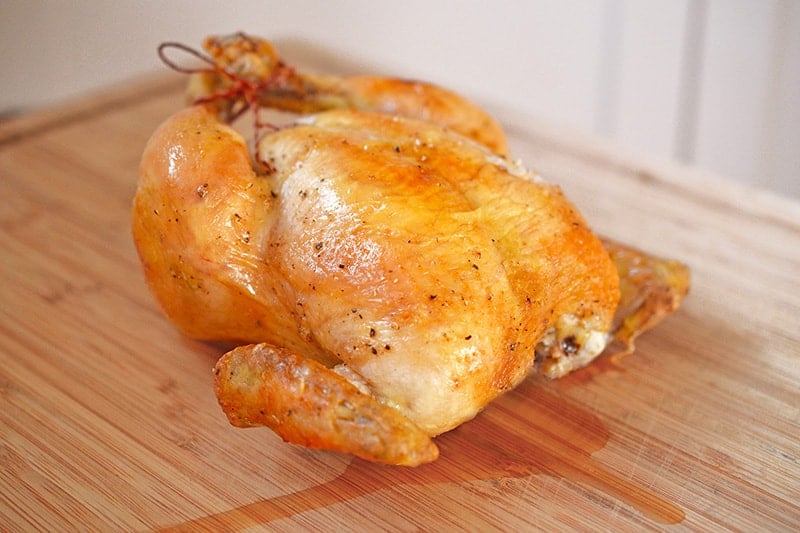
…we have time to whip up a quick pan sauce!
Remove all but 1 tablespoon of fat from the skillet. Leave the extra jus and brown bits in the pan. Then, heat the contents of the skillet over a medium-high burner. Once the liquid starts bubbling, throw in the shallots. Cook the shallots until softened.
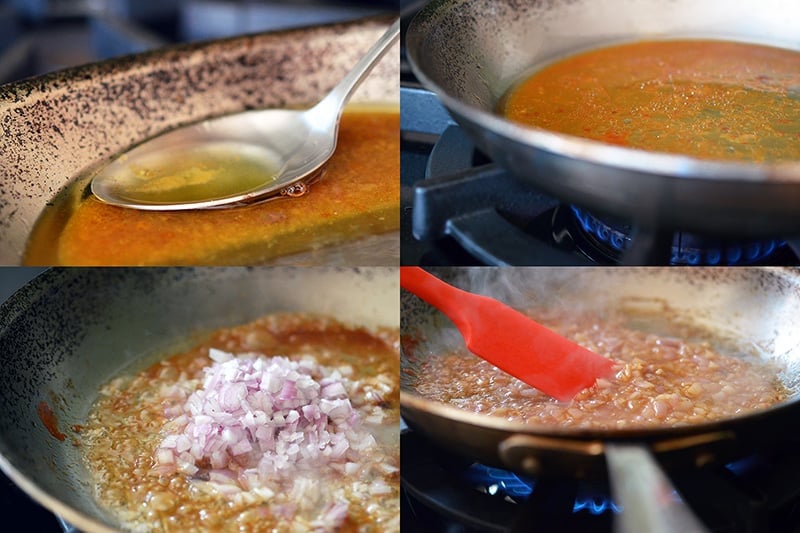
Then, pour in the broth and the mustard, scraping up any tasty browned bits on the bottom of the pan. Simmer until reduced to ¾ cup.
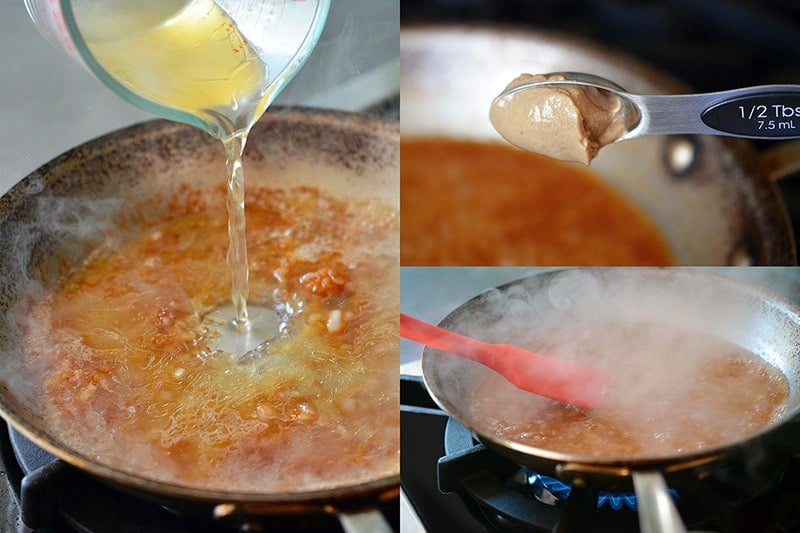
When the sauce is ready, remove it from the heat. Grab the chilled butter or ghee (use the latter if you’re on a Whole30!), and slowly whisk it into the sauce along with the lemon juice and minced tarragon. Season with salt and pepper to taste.
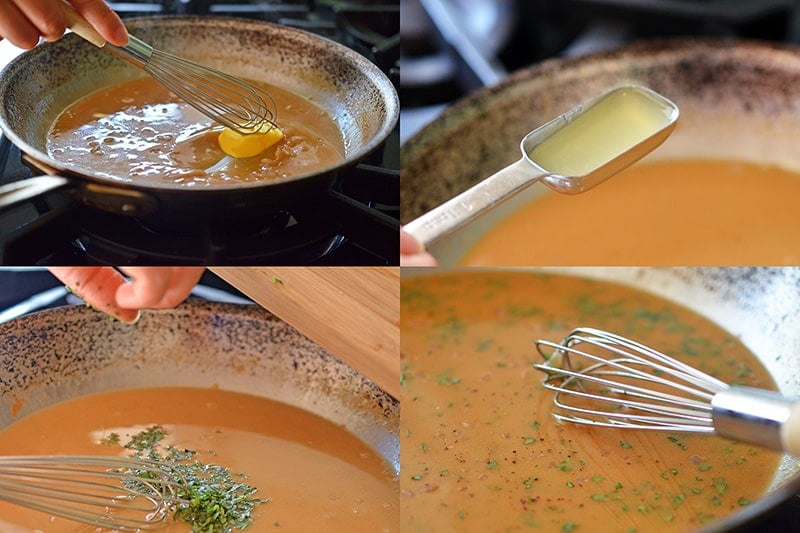
Serve the chicken with the gravy!
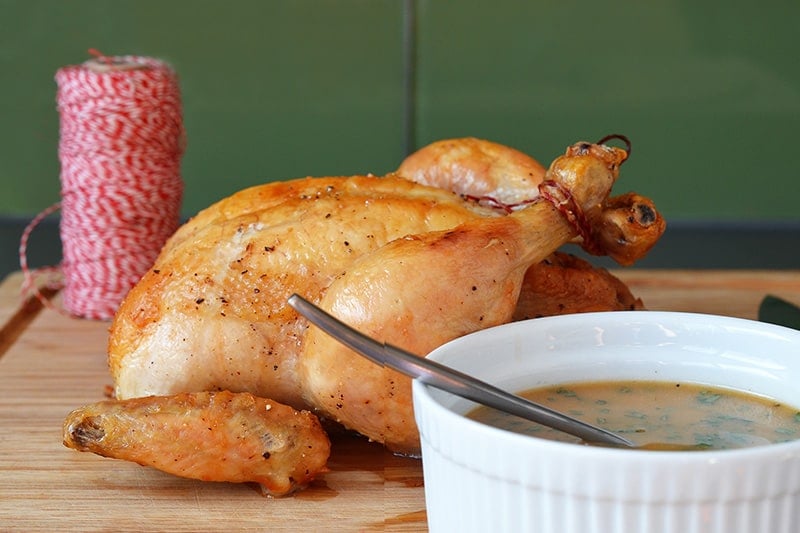
Voilà: the perfect roast chicken!
What can you serve with the chicken?
How to save leftovers
You can save leftover roast chicken in an airtight container in the fridge for up to 4 days or in the freezer for up to 3 months
More weeknight chicken recipes!
Looking for more recipe ideas? Head on over to my Recipe Index. You’ll also find exclusive recipes in my cookbooks, Nom Nom Paleo: Food for Humans (Andrews McMeel Publishing 2013), Ready or Not! (Andrews McMeel Publishing 2017), and Nom Nom Paleo: Let’s Go! (Andrews McMeel Publishing 2022).
Weeknight Roast Chicken
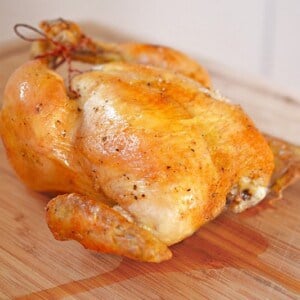
Ingredients
Ingredients for the chicken:
- 1 tablespoon Diamond Crystal brand kosher salt
- ½ teaspoon freshly ground black pepper
- 1 3½- to 4-pound whole chicken, giblets discarded
- 1 tablespoon melted ghee or fat of choice
For the optional Tarragon-Lemon Pan Sauce:
- 1 shallot minced
- 1 cup chicken broth or bone broth
- 2 teaspoons Dijon mustard
- 2 tablespoons unsalted butter or cold ghee for folks doing a Whole30
- 2 teaspoons minced fresh tarragon
- 2 teaspoons lemon juice
- Freshly ground black pepper
Instructions
- Position your oven rack in the middle position, place a 12-inch oven-safe skillet on it, shut the oven door, and crank the heat up to 450°F.
- Mix together the salt and pepper in a small bowl, and grab the melted ghee.
- Pat the chicken dry with paper towels. Pull off any extra fat around the open cavity, and trim away any extraneous skin.
- Brush the entire surface of the bird with melted ghee. If your chicken is still cold from sitting in the refrigerator, the ghee may clump up a bit upon contact with the bird, but that’s no biggie.
- Sprinkle the salt and pepper mixture all over the surface and interior of the bird. Then, massage in the seasoning with your hands.
- Tuck the chicken wings behind the back to keep ’em from burning in the oven, and tie the legs together with a piece of kitchen twine.
- Place your bird breast-side up in the hot skillet in the oven. Remember that your skillet’s hot—don’t burn your hand.
- Roast the chicken until the breast registers 120°F and thighs are 135°F, about 25 to 35 minutes. (If you haven’t already invested in a meat thermometer, I recommend that you do it. It’s a great insurance policy against ruined dinners.)
- Immediately turn off the oven, leaving the chicken inside until the breast reaches 160°F and thighs are 175°F, about 25 to 35 more minutes. Again, use your meat thermometer to check your bird for readiness.
- Remove the chicken from the pan and rest it for 20 minutes.
- While the chicken’s resting, whip up a quick pan sauce! Remove all but 1 tablespoon of fat from the skillet. Leave the extra jus and brown bits in the pan. Then, heat the contents of the skillet over a medium-high burner. Once the liquid starts bubbling, throw in the shallots. Cook the shallots until softened.
- Then, pour in the broth and the mustard, scraping up any tasty browned bits on the bottom of the pan. Simmer until reduced to ¾ cup.
- When the sauce is ready, remove it from the heat. Grab the chilled butter or ghee (use the latter if you’re on a Whole30!), and slowly whisk it into the sauce along with the lemon juice and minced tarragon. Season with salt and pepper to taste. Serve the chicken with the sauce!
Notes
- I used to use a pair of tongs to transfer roast chicken from pan to plate, but found that the teeth of my tongs would tear the beautifully crisp, golden skin. The solution? I now insert the handle-end of a sturdy wooden spoon or spatula into the bird’s cavity to lift it up and out—and to drain out any excess juices from the inside of the chicken.
- Pair it with a simple salad or roasted vegetables, and treat your family to a midweek feast!
Nutrition
Nutrition information is automatically calculated, so should only be used as an approximation.
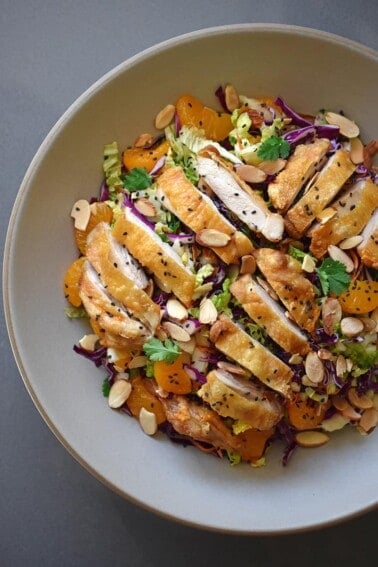

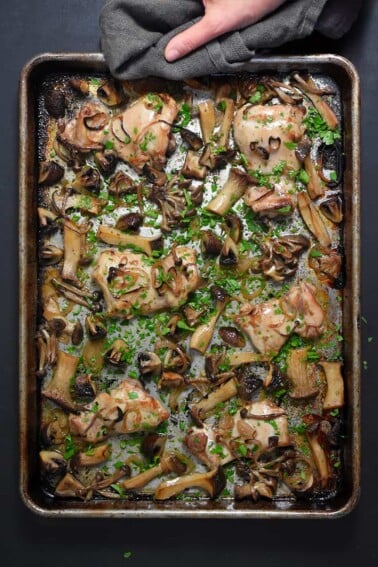
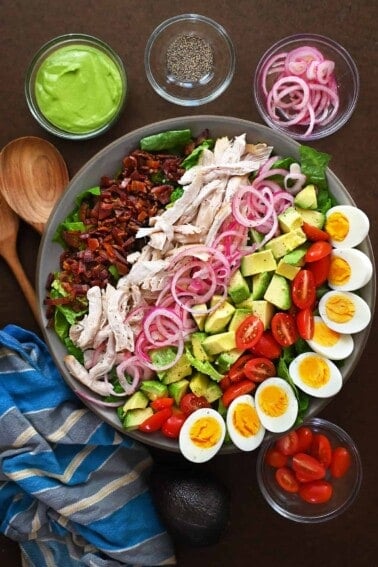
This was my first time cooking a whole chicken and it came out amazing. Im very picky about recipes for great tatste and strict about paleo eating. Thank you for this perfect cooked chicken confidence builder!
Thank you for the wonderful recipe and the ATK cookbook recommendation. Would it work to use a cast iron skillet? I am not sure if my other skillets are oven safe.
Cast iron works!
Love this recipe, but every time I make it the chicken juices start smoking in the pan and my fire alarm goes off! Any tips to keep the smoke down? (I’m using ghee and placing the chicken in a cast iron skillet.) Thanks!
Not sure! Sometimes cast iron skillets can smoke because folks rarely scrub them well because they’re afraid of stripping the seasoning.
Shouldn’t the chicken be left to sit out of fridge first? #4 in your instructions says ” If your chicken is cold from the fridge” I would think that would affect/ determine the cooking time and MAYBE ?? cause outside of bird getting done much before the deeper internal meat ? Any clarifications ?
You will be using a meat thermometer to determine when to remove the chicken from the oven. Per this article, letting meat sit at room temperature before cooking doesn’t really change the cooking time: https://www.seriouseats.com/2013/06/the-food-lab-7-old-wives-tales-about-cooking-steak.html
Great to see this recipe from ATK on your site! We’ve been using this method for years and it’s almost foolproof. Brining (7%, 12 hours) does make the chicken more juicy, but who has time for that during the week — totally optional, but worth it if you have the time and have planned ahead. I do recommend putting a half a lemon, half a head of garlic, and some thyme sprigs in the cavity of the chicken before trussing. It only adds about 2 minutes to the process and does provide a nice additional perfume to the finished chicken. I always use a cast iron skillet, and have begun adding some halved fingerling potatoes, carrots, pearl onions, etc. to the pan at the stage where the oven is turned off. It’s usually enough time to roast the vegetables perfectly, but if they still need a bit more, you can finish while the chicken rests. Roasting the root vegetables in the rendered chicken fat and jus makes them insanely good. Thanks for posting!
Any ideas for what to do with the left overs.
Can I used the cooked chicken in any of your recipes for the following day?
Yes! You can add it to this soup: https://nomnompaleo.com/instant-pot-vegetable-soup or add use it in one of these salads: https://nomnompaleo.com/9-whole30-salad-recipes
I followed the recipe, 35min cooking at 450, 35 mn with heat off oven door shut. Chicken still raw even without a thermometer. Placed back in on a flat pan, 15min at 450, chicken done, tasted great. Lesson, leave in for 45 min at 450.
This was excellent! Thank you so much for the recipe. I’ve seen it a dozen times on ATK but never wrote it down. I found your site and tried it tonight. Absolute perfection!
How do you remove the fat in the saucepan (except for the one tablespoon)? Do you have any tricks? At one point I had a slanted measuring cup, but I never could figure out how to use it!
Normally the recipes work great for me but this one was an anomaly. I followed the directions as written but my chicken was not done (about 10 degrees too low) so I ended up heating the oven to 400 and cooking for an additional 20 mins. You may need to adjust timing for different ovens.
Game changer for me. (I do need to cook my chicken a little longer due to how my oven heats). I now cook my wings this way as well. The lemon paragon sauce is amazing.